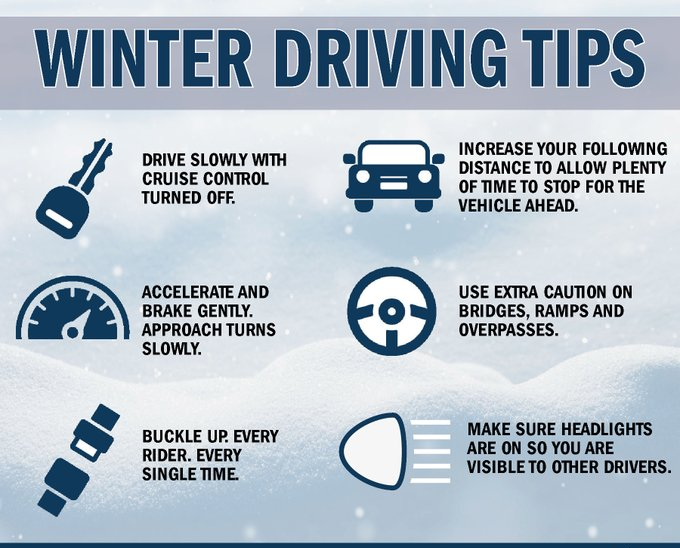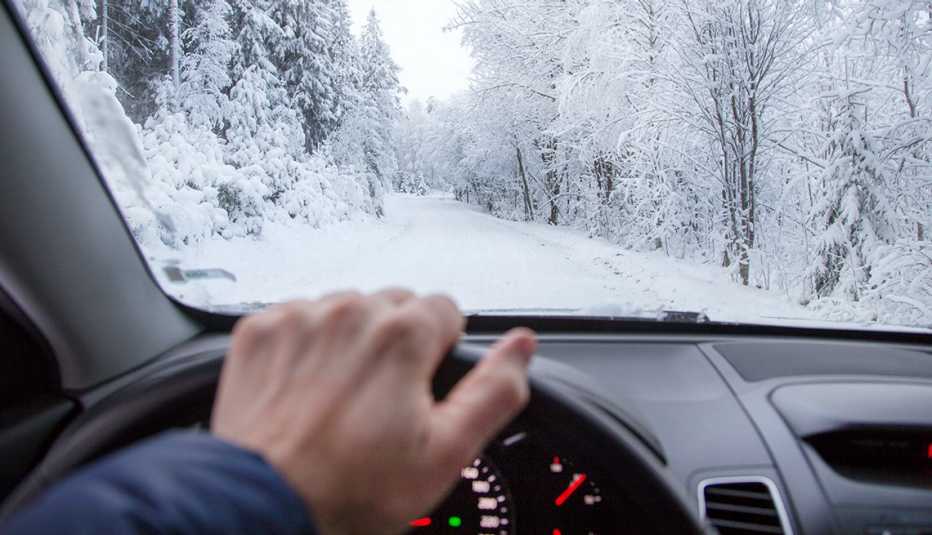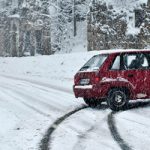Winter driving means lots of challenges: Roads can be slick and icy, blowing snow can cause poor visibility and frosty weather can do a number on just about any vehicle.
It’s imperative to use safe driving techniques and to be prepared when winter comes along. More than 70 percent of America’s roads are in areas that get an average of more than 5 inches of snow, according to the U.S. Department of Transportation’s Federal Highway Administration.
That snow, ice and winter weather increase the risk of accidents and crashes, according to the Federal Highway Administration:
- 24 percent of weather-related crashes happen on snowy, slushy or icy pavement.
- 15 percent of those crashes happen during snow or sleet.
- More than 1,300 people are killed and more than 116,800 people are injured per year in vehicle crashes on snowy, slushy or icy pavement.
- Annually, nearly 900 people are killed and 76,000 injured during snow or sleet.

Even if you live in a warm spot, you benefit from knowing how to drive safely on winter roads for the times you visit friends or family who inhabit four-season states.
Winter driving tips
Here are some tips to make sure you and your vehicle are prepared for winter driving:
1. Stay home if you can
Monitor weather reports along your expected route. If bad weather is expected, try to delay your journey. If it’s sleeting or snowing, stay home if possible and stay off the roads. If you set out, make sure to alert someone to your plan and route.
2. Focus on the details
Batteries weaken in cold. After three winters, yours might need replacing. Turn on the headlights, then start the engine. If the lights brighten when the engine is running, your battery’s weak. Make sure windshield washer fluid and engine antifreeze levels are full.
3. Get winter equipment ready
Winter gear should include battery jumper cables, a snow brush/ice scraper, cat litter or sand to put under slipping wheels if you’re stuck, a small shovel, a flashlight and batteries, a phone charger, drinking water and snacks. Consider taking a container for bathroom use in case you get stuck inside the car. Keep plenty of fuel in the tank in case you must run the engine to stay warm during delays. All-season tires will handle light snow. For heavier snow, use snow tires or tire chains.
4. Get rid of ice and slush
Clean the inside and outside of the windshield and rear window. Defrost and deice the windshield before you drive instead of hoping the defroster will handle it as you drive. Wipe snow and slush off your headlights.
5. Stay visible
Keep your brake lights and turn signals as snow-free as possible. Use your headlights in daytime to make your vehicle stand out from the drab winter background. Have reflective triangles and/or a reflective vest to wear if you get stuck and need to exit the car for help.
6. Accelerate gently
Trying to start too quickly, even with all-wheel drive or traction control, can leave you stuck in place. Abruptly changing speeds — up or down — can cause the tires to slip and spin.
7. Use proper stopping techniques
Your car or truck probably has an antilock brake system (ABS). They keep the wheels from skidding under hard braking. That lets you keep steering while stopping. If you were taught to pump the brakes, forget that with ABS. Safety folks preach, “Stomp, stay, steer.” Stomp, hard, on the brake pedal. Stay on the pedal, hard, despite vibrations or kickback. Steer around the danger instead of crashing into it. Not intuitive, perhaps, so practice at low speeds in an empty parking lot or on a long driveway.
8. Avoid skidding
If the back end of the car or truck begins to slide sideways on a slippery surface, turn the steering wheel the same direction as the back end is moving. If it’s dancing out to the left, turn the wheel to the left; if right, turn right. Otherwise, you’ll turn the skid into a spin. Anti-skid control, common on most cars, helps, but it can’t prevent all slick-road skids.

9. Pack supplies for emergencies
Stuck in the Snow?
If you venture out on the roads during a storm and happen to get stuck, AAA has these recommendations:
Stay in your car: This protects you from the elements and makes it easier for rescuers to find you. Don’t try to walk for help in a storm since it’s easy to get lost.
Don’t tire yourself out: If you’re trying to dig your car out, rest or stop altogether if you feel winded or ill.
Clear the exhaust pipe: Make sure the external exhaust pipe on your car is not blocked or clogged with snow. A blocked pipe can cause carbon monoxide to leak into your car when the engine is running, which can be deadly.
Conserve fuel: Only run the engine and heater long enough to keep away the chill.
Blankets or small candles in containers can warm the inside of the car if you’re stranded. If you use candles, open a window slightly because candles consume oxygen and emit poisonous carbon dioxide. If you keep the engine running to stay warm, open a couple of windows a bit for fresh air in case there’s an exhaust-system leak — also poison — that could seep into the car’s interior.


